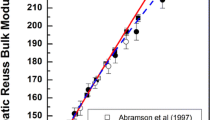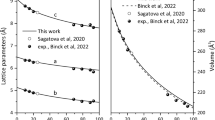Abstract
Tuite forms by the breakdown of apatite at high pressure and is thus expected to play a role in extending the phosphorus cycle beyond the stability field of apatite and into the lower mantle. With its large, high-coordination cation sites, tuite is thought to be able to dissolve large quantities of incompatible elements such as rare earth elements, Sr, Th, and U, and is potentially an important mantle reservoir for these elements. In this paper, ab initio calculations of the structure and elasticity of tuite to lower mantle pressure are presented and used to probe trace element incorporation. The calculated zero-pressure volumes of the M1 and M2 cation sites were 50.23 and 36.61 Å3, while the corresponding bulk moduli K 0 are 116.1 and 94.2 GPa, significantly lower than the 234.1 GPa calculated for the M site of CaSiO3 perovskite (cpv), another likely host for incompatible elements in the mantle. The partitioning of impurities between tuite and cpv is investigated using a lattice strain model, parameterized by the ab initio calculations, to calculate isovalent substitution energies across a range of pressures and impurity sizes. Additionally, energies of strontium and barium defects in tuite are compared with those of equivalent defects in cpv, and it is found that both elements will partition strongly from cpv into tuite.







Similar content being viewed by others
References
Adams DJ, Oganov AR (2006) Ab initio molecular dynamics study of CaSiO3 perovskite at P–T conditions of Earth’s lower mantle. Phys Rev B 73:184106. doi:10.1103/PhysRevB.73.184106
Blundy J, Wood B (1994) Prediction of crystal–melt partition coefficients from elastic moduli. Nature 372:452–454. doi:10.1038/372452a0
Born M (1940) On the stability of crystal lattices. I. Math Proc Cambridge Philos Soc 36:160–172. doi:10.1017/S0305004100017138
Brice JC (1975) Some thermodynamic aspects of the growth of strained crystals. J Cryst Growth 28:249–253. doi:10.1016/0022-0248(75)90241-9
Caracas R, Wentzcovitch R, Price GD, Brodholt J (2005) CaSiO3 perovskite at lower mantle pressures. Geophys Res Lett 32:L06306. doi:10.1029/2004GL022144
Corgne A, Liebske C, Wood BJ et al (2005) Silicate perovskite-melt partitioning of trace elements and geochemical signature of a deep perovskitic reservoir. Geochim Cosmochim Acta 69:485–496. doi:10.1016/j.gca.2004.06.041
Giannozzi P, Baroni S, Bonini N et al (2009) QUANTUM ESPRESSO: a modular and open-source software project for quantum simulations of materials. J Phys Condens Matter 21:395502. doi:10.1088/0953-8984/21/39/395502
Hazen RM, Finger LW (1979) Bulk modulus—volume relationship for cation–anion polyhedra. J Geophys Res 84:6723–6728. doi:10.1029/JB084iB12p06723
Hill R (1952) The elastic behaviour of a crystalline aggregate. Proc Phys Soc A 65:349. doi:10.1088/0370-1298/65/5/307
Hohenberg P, Kohn W (1964) Inhomogeneous electron gas. Phys Rev 136:B864–B871. doi:10.1103/PhysRev.136.B864
Ionov DA, Hofmann AW, Merlet C et al (2006) Discovery of whitlockite in mantle xenoliths: inferences for water- and halogen-poor fluids and trace element residence in the terrestrial upper mantle. Earth Planet Sci Lett 244:201–217. doi:10.1016/j.epsl.2006.02.012
Jung DY, Oganov AR (2005) Ab initio study of the high-pressure behavior of CaSiO3 perovskite. Phys Chem Miner 32:146–153. doi:10.1007/s00269-005-0453-z
Karki BB, Crain J (1998) First-principles determination of elastic properties of CaSiO3 perovskite at lower mantle pressures. Geophys Res Lett 25:2741–2744. doi:10.1029/98GL51952
Karki BB, Wentzcovitch RM, de Gironcoli S, Baroni S (1999) First-principles determination of elastic anisotropy and wave velocities of MgO at lower mantle conditions. Science 286:1705–1707. doi:10.1126/science.286.5445.1705
Kohn W, Sham LJ (1965) Self-consistent equations including exchange and correlation effects. Phys Rev 140:A1133–A1138. doi:10.1103/PhysRev.140.A1133
Lee KKM, Steinle-Neumann G, Akber-Knutson S (2009) Ab initio predictions of potassium partitioning between Fe and Al-bearing MgSiO3 perovskite and post-perovskite. Phys Earth Planet Inter 174:247–253. doi:10.1016/j.pepi.2008.09.003
Li B, Kung J, Liu W, Liebermann RC (2014) Phase transition and elasticity of enstatite under pressure from experiments and first-principles studies. Phys Earth Planet Inter 228:63–74. doi:10.1016/j.pepi.2013.11.009
Luo F, Cheng Y, Cai L-C, Chen X-R (2013) Structure and thermodynamic properties of BeO: empirical corrections in the quasiharmonic approximation. J Appl Phys 113:33517. doi:10.1063/1.4776679
Momma K, Izumi F (2011) VESTA 3 for three-dimensional visualization of crystal, volumetric and morphology data. J Appl Crystallogr 44:1272–1276. doi:10.1107/S0021889811038970
Monkhorst HJ, Pack JD (1976) Special points for Brillouin-zone integrations. Phys Rev B 13:5188–5192. doi:10.1103/PhysRevB.13.5188
Mouhat F, Coudert F-X (2014) Necessary and sufficient elastic stability conditions in various crystal systems. Phys Rev B 90:224104. doi:10.1103/PhysRevB.90.224104
Murayama JK, Nakai S, Kato M, Kumazawa M (1986) A dense polymorph of Ca3(PO4)2: a high pressure phase of apatite decomposition and its geochemical significance. Phys Earth Planet Inter 44:293–303. doi:10.1016/0031-9201(86)90057-9
Oganov AR, Brodholt JP, Price GD (2001) Ab initio elasticity and thermal equation of state of MgSiO3 perovskite. Earth Planet Sci Lett 184:555–560. doi:10.1016/S0012-821X(00)00363-0
Ono S (2008) Experimental constraints on the temperature profile in the lower mantle. Phys Earth Planet Inter 170:267–273. doi:10.1016/j.pepi.2008.06.033
Otero-de-la-Roza A, Luaña V (2011) Equations of state and thermodynamics of solids using empirical corrections in the quasiharmonic approximation. Phys Rev B 84:184103. doi:10.1103/PhysRevB.84.184103
Otero-de-la-Roza A, Abbasi-Pérez D, Luaña V (2011) Gibbs2: a new version of the quasiharmonic model code. II. Models for solid-state thermodynamics, features and implementation. Comput Phys Commun 182:2232–2248. doi:10.1016/j.cpc.2011.05.009
Perdew JP, Zunger A (1981) Self-interaction correction to density-functional approximations for many-electron systems. Phys Rev B 23:5048–5079. doi:10.1103/PhysRevB.23.5048
Perdew JP, Burke K, Ernzerhof M (1996) Generalized gradient approximation made simple. Phys Rev Lett 77:3865–3868. doi:10.1103/PhysRevLett.77.3865
Pfrommer BG, Côté M, Louie SG, Cohen ML (1997) Relaxation of crystals with the quasi-Newton method. J Comput Phys 131:233–240. doi:10.1006/jcph.1996.5612
Ranganathan SI, Ostoja-Starzewski M (2008) Universal elastic anisotropy index. Phys Rev Lett 101:55504. doi:10.1103/PhysRevLett.101.055504
Shannon RD (1976) Revised effective ionic radii and systematic studies of interatomic distances in halides and chalcogenides. Acta Crystallogr Sect A 32:751–767. doi:10.1107/S0567739476001551
Shim S-H, Jeanloz R, Duffy TS (2002) Tetragonal structure of CaSiO3 perovskite above 20 GPa. Geophys Res Lett 29:2166. doi:10.1029/2002GL016148
Stackhouse S, Brodholt JP, Wookey J et al (2005) The effect of temperature on the seismic anisotropy of the perovskite and post-perovskite polymorphs of MgSiO3. Earth Planet Sci Lett 230:1–10. doi:10.1016/j.epsl.2004.11.021
Sugiyama K, Tokonami M (1987) Structure and crystal chemistry of a dense polymorph of tricalcium phosphate Ca3 (PO4)2: a host to accommodate large lithophile elements in the earth’s mantle. Phys Chem Miner 15:125–130. doi:10.1007/BF00308774
Sugiyama K, Tokonami M (1990) The crystal structure refinements of the strontium and barium orthophosphates. Mineral J 15:141–146. doi:10.2465/minerj.15.141
Sun T, Zhang D-B, Wentzcovitch RM (2014) Dynamic stabilization of cubic CaSiO3 perovskite at high temperatures and pressures from ab initio molecular dynamics. Phys Rev B 89:94109. doi:10.1103/PhysRevB.89.094109
Thompson RM, Xie X, Zhai S et al (2013) A comparison of the Ca3(PO4)2 and CaSiO3 systems, with a new structure refinement of tuite synthesized at 15 GPa and 1300 °C. Am Miner 98:1585–1592. doi:10.2138/am.2013.4435
van Westrenen W, Allan NL, Blundy JD et al (2000) Atomistic simulation of trace element incorporation into garnets—comparison with experimental garnet-melt partitioning data. Geochim Cosmochim Acta 64:1629–1639. doi:10.1016/S0016-7037(00)00336-7
Vanderbilt D (1990) Soft self-consistent pseudopotentials in a generalized eigenvalue formalism. Phys Rev B 41:7892–7895. doi:10.1103/PhysRevB.41.7892
Vanderbilt D (1998) First-principles theory of structural phase transitions in cubic perovskites. J Korean Phys Soc 32:S103–S106
Vinet P, Ferrante J, Smith JR, Rose JH (1986) A universal equation of state for solids. J Phys C Solid State Phys 19:L467. doi:10.1088/0022-3719/19/20/001
Walker AM (2012) The effect of pressure on the elastic properties and seismic anisotropy of diopside and jadeite from atomic scale simulation. Phys Earth Planet Inter 192–193:81–89. doi:10.1016/j.pepi.2011.10.002
Walker AM, Tyer RP, Bruin RP, Dove MT (2008) The compressibility and high pressure structure of diopside from first principles simulation. Phys Chem Miner 35:359–366. doi:10.1007/s00269-008-0229-3
Wentzcovitch RM, Ross NL, Price GD (1995) Ab initio study of MgSiO3 and CaSiO3 perovskites at lower-mantle pressures. Phys Earth Planet Inter 90:101–112. doi:10.1016/0031-9201(94)03001-Y
Wood BJ (2000) Phase transformations and partitioning relations in peridotite under lower mantle conditions. Earth Planet Sci Lett 174:341–354. doi:10.1016/S0012-821X(99)00273-3
Wood BJ, Blundy JD (1997) A predictive model for rare earth element partitioning between clinopyroxene and anhydrous silicate melt. Contrib Mineral Petrol 129:166–181. doi:10.1007/s004100050330
Xie X, Minitti ME, Chen M et al (2003) Tuite, γ-Ca3(PO4)2: a new mineral from the Suizhou L6 chondrite. Eur J Mineral 15:1001–1005. doi:10.1127/0935-1221/2003/0015-1001
Xie X, Gu X, Chen M (2016) An occurrence of tuite, γ-Ca3(PO4)2, partly transformed from Ca-phosphates in the Suizhou meteorite. Meteorit Planet Sci 51:195–202. doi:10.1111/maps.12577
Zhai S, Liu X, Shieh SR et al (2009) Equation of state of γ-tricalcium phosphate, γ-Ca3(PO4)2, to lower mantle pressures. Am Miner 94:1388–1391. doi:10.2138/am.2009.3160
Zhai S, Xue W, Yamazaki D et al (2011) Compressibility of strontium orthophosphate Sr3(PO4)2 at high pressure. Phys Chem Miner 38:357–361. doi:10.1007/s00269-010-0409-9
Zhai S, Yamazaki D, Xue W et al (2013) P-V-T relations of γ-Ca3(PO4)2 tuite determined by in situ X-ray diffraction in a large-volume high-pressure apparatus. Am Miner 98:1811–1816. doi:10.2138/am.2013.4403
Zhai S, Xue W, Yamazaki D, Ma F (2014) Trace element composition in tuite decomposed from natural apatite in high-pressure and high-temperature experiments. Sci China Earth Sci 57:2922–2927. doi:10.1007/s11430-014-4980-7
Acknowledgements
Calculations were performed on the Terrawulf cluster, a computational facility supported through the AuScope initiative. AuScope Ltd is funded under the National Collaborative Research Infrastructure Strategy (NCRIS), an Australian Commonwealth Government Programme. Ian Jackson, Mark Ghiorso, and an anonymous reviewer are thanked for their helpful comments. AMW is grateful for support from the UK Natural Environment Research Council (NE/K008803/1 and NE/M000044/1). RS is supported by an Australian Government Research Training Program (RTP) Scholarship.
Author information
Authors and Affiliations
Corresponding author
Additional information
Communicated by Mark S Ghiorso.
Rights and permissions
About this article
Cite this article
Skelton, R., Walker, A.M. Ab initio crystal structure and elasticity of tuite, γ-Ca3(PO4)2, with implications for trace element partitioning in the lower mantle. Contrib Mineral Petrol 172, 87 (2017). https://doi.org/10.1007/s00410-017-1406-5
Received:
Accepted:
Published:
DOI: https://doi.org/10.1007/s00410-017-1406-5




